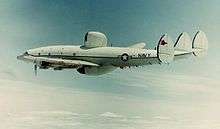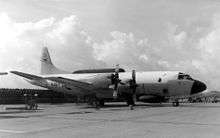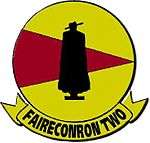VQ-2
| Fleet Air Reconnaissance Squadron VQ-1 | |
|---|---|
|
VQ-2 insignia | |
| Active | 1 September 1955 - 22 May 2012 |
| Country | United States |
| Branch |
|
| Type | Fleet Air Reconnaissance |
| Role |
Aerial reconnaissance Electronic reconnaissance |
| Garrison/HQ | Naval Air Station Whidbey Island |
| Nickname(s) |
"Batmen" "Sandeman" |
| Engagements |
Vietnam War 1982 Lebanon War Beirut Crisis Operation El Dorado Canyon Gulf War Operation Deny Flight Operation Provide Comfort Operation Provide Promise Operation Sharp Guard Operation Join Endeavor Operation Decisive Endeavor Operation Deliberate Guard Operation Silver Wake Operation Enduring Freedom |
| Aircraft flown | |
| Reconnaissance |
Lockheed EP-3 WV-2Q Super Constellations EA-3 Skywarrior P-4M-1Q Mercator |
Fleet Air Reconnaissance Squadron VQ-2, also known as "Batemen" and later "Sandeman," was an air reconnaissance squadron of the United States Navy was established on 1 September 1955 and based at NAS Whidbey Island, flying Lockheed EP-3 aircraft. The squadron was disestablished on 22 May 2012.
Squadron History
1960s

VQ-2 was commissioned on 1 September 1955 to provide the United States with an improved defense posture. Designated Electronic Countermeasures Squadron TWO (ECMRON TWO) at the outset, it was homeported at NAS Port Lyautey.[1]
The squadron originally utilized the P-4M-1Q Mercator and the P-2V Neptune as mission aircraft. In September 1956, a new and faster carrier-capable A-3D-1Q Skywarrior. In January 1960, the squadron was transferred to NS Rota, Spain.[1]
In early 1960, the squadron's name was changed to Fleet Air Reconnaissance Squadron TWO (VQ-2). Shortly thereafter, the P4M-1Q aircraft were replaced by the WV-2Q Super Constellations. In October 1962, the WV-2Q was redesignated the EC-121M Super Constellation.[1]
1970s

On 26 February 1970 an EA-3B was lost while operating from USS Franklin D. Roosevelt in the Mediterranean. The catapult system malfunctioned in mid-stroke, resulting in the Skywarrior “dribbling” off the bow and being run over by the carrier. Four of the crew members died in the accident[2]
VQ-2 continued to operate and maintain EC-121M aircraft into 1974. The A3D-1Q was replaced by the A3D-2Q and was subsequently re-designated the EA-3B Skywarrior.[1]
On 31 July 1971, the squadron received its first delivery of the EP-3E Aries aircraft.[1]
1980s
_c1986.jpg)
As VQ-2 entered the mid-1980s, the frenzied pace of operations including Operation Mole Cricket 19(Arab-Israel Beqaa War), and continuing with 1982 - 1983 Beirut Crisis with the U.S. Marine barracks bombing, and the Sixth Fleet December 1983 air strike into Lebanon, allowed little leisure time for the squadron.[2]
VQ-2 was awarded the Navy Expeditionary Medal for participation in the Beirut evacuation and operations in the vicinity of Libya during Operation El Dorado Canyon, 12–17 April 1986.[1]
1990s
In the summer of 1990, the squadron provided electronic reconnaissance during the evacuation of 2000 non-combatant personnel from war-stricken Liberia in operation Sharp Edge.[1]
%2C_USA_-_Navy_AN2094464.jpg)
From August 1990 to April 1991, VQ-2 provided combat reconnaissance during operations Desert Shield/Desert Storm, Proven Force, and Provide Comfort.[1]
On 29 June 1991, the first EP-3E Aries II aircraft arrived in Rota and on 20 September 1991, the squadron retired the EA-3B Skywarrior the same year.[1]
Starting in July 1992, VQ-2 flew support missions with Operations Deny Flight, Provide Promise, Sharp Guard, Joint Endeavor, Decisive Endeavor, and Deliberate Guard providing combat reconnaissance and intelligence to NATO and United Nations forces in the Former Yugoslavia.[1]
As of 1997 VQ-2 operated four EP-3E Aries II aircraft and two P-3C Orion aircraft from its home-base at Rota and two-plane detachment at Naval Support Activity Souda Bay, Crete.[1]
In March 1997, VQ-2 provided electronic reconnaissance during the evacuation of non-combatant personnel from Albania following unrest from a failed pyramid savings scheme during Operation Silver Wake.[1]
2000s
VQ-2 relocated from NS Rota, Spain, to NAS Whidbey Island, effective 1 September 2005. The relocation of VQ-2's six aircraft and 450 Sailors to the United States was in keeping with the Navy's ongoing transformation of forces in Europe, and helped reduce costs and eliminate redundancies throughout its force structure worldwide. The move co-located the squadron with VQ-1, already based at NAS Whidbey Island, and realized efficiency through the consolidation of personnel deployment practices, aircraft maintenance practices and air crew training for these unique Navy squadrons.[3]
2010s
The squadron was disestablished on 22 May 2012 ending 57 years of service. The last squadron commander was Commander Mark Stockfish.[4]
References
- 1 2 3 4 5 6 7 8 9 10 11 12 "VQ-2 Fleet Air Reconnaissance Squadron TWO". www.globalsecurity.org. Retrieved 2015-11-06.
- 1 2 "Cold War Museum". www.coldwar.org. Retrieved 2015-11-08.
- ↑ "VQ-2 Scheduled for Homeport Change". www.navy.mil. Retrieved 2015-11-08.
- ↑ "A sad day at NAS Whidbey as VQ-2 disestablished - Whidbey News-Times". Whidbey News-Times. Retrieved 2015-11-06.

